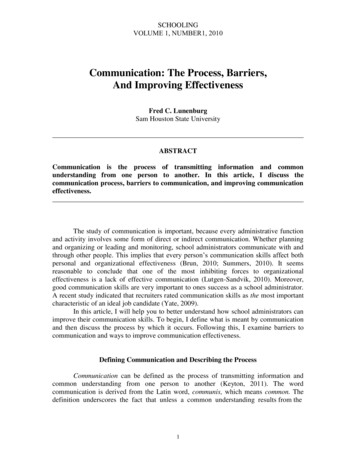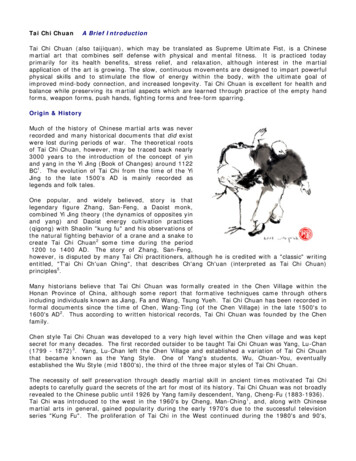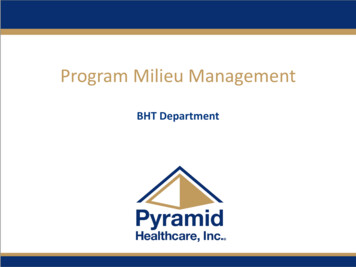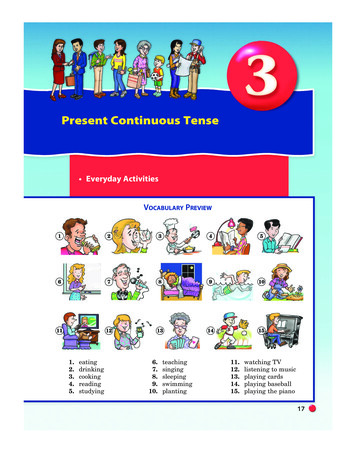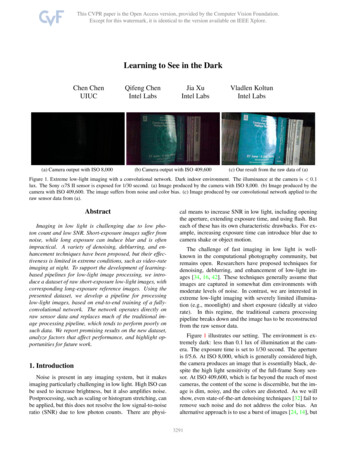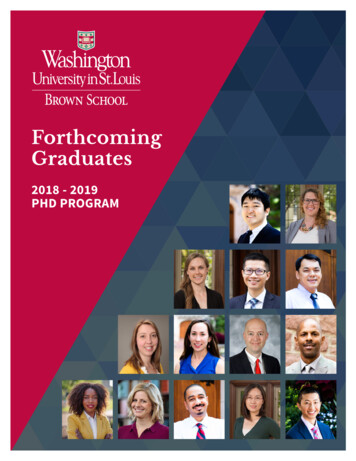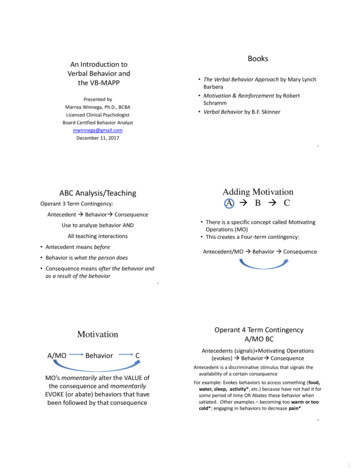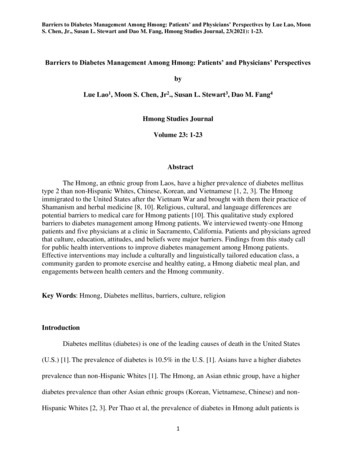
Transcription
Barriers to Diabetes Management Among Hmong: Patients’ and Physicians’ Perspectives by Lue Lao, MoonS. Chen, Jr., Susan L. Stewart and Dao M. Fang, Hmong Studies Journal, 23(2021): 1-23.Barriers to Diabetes Management Among Hmong: Patients’ and Physicians’ PerspectivesbyLue Lao1, Moon S. Chen, Jr2., Susan L. Stewart3, Dao M. Fang4Hmong Studies JournalVolume 23: 1-23AbstractThe Hmong, an ethnic group from Laos, have a higher prevalence of diabetes mellitustype 2 than non-Hispanic Whites, Chinese, Korean, and Vietnamese [1, 2, 3]. The Hmongimmigrated to the United States after the Vietnam War and brought with them their practice ofShamanism and herbal medicine [8, 10]. Religious, cultural, and language differences arepotential barriers to medical care for Hmong patients [10]. This qualitative study exploredbarriers to diabetes management among Hmong patients. We interviewed twenty-one Hmongpatients and five physicians at a clinic in Sacramento, California. Patients and physicians agreedthat culture, education, attitudes, and beliefs were major barriers. Findings from this study callfor public health interventions to improve diabetes management among Hmong patients.Effective interventions may include a culturally and linguistically tailored education class, acommunity garden to promote exercise and healthy eating, a Hmong diabetic meal plan, andengagements between health centers and the Hmong community.Key Words: Hmong, Diabetes mellitus, barriers, culture, religionIntroductionDiabetes mellitus (diabetes) is one of the leading causes of death in the United States(U.S.) [1]. The prevalence of diabetes is 10.5% in the U.S. [1]. Asians have a higher diabetesprevalence than non-Hispanic Whites [1]. The Hmong, an Asian ethnic group, have a higherdiabetes prevalence than other Asian ethnic groups (Korean, Vietnamese, Chinese) and nonHispanic Whites [2, 3]. Per Thao et al, the prevalence of diabetes in Hmong adult patients is1
Barriers to Diabetes Management Among Hmong: Patients’ and Physicians’ Perspectives by Lue Lao, MoonS. Chen, Jr., Susan L. Stewart and Dao M. Fang, Hmong Studies Journal, 23(2021): 1-23.19.1% compared to 7.8% in non-Hispanic White adult patients. So, Hmong are 3.3 times morelikely to have diabetes than non-Hispanic Whites [3]. The Hmong are an ethnic group native toSoutheast Asia (Laos, Vietnam, and Thailand) [4]. The Hmong in Laos were recruited by theCentral Intelligence Agency to fight in the Vietnam War [4]. When the war ended, the Hmongfaced war persecution, so thousands of Hmong immigrated to the U.S. in the early 1980s to early2000s [4]. The Hmong are one of the fastest growing immigrant groups in the U.S. Between1990 and 2010, the U.S. Hmong population grew by 175%, from 94,439 in 1990 to 260,073 in2010 [5, 6]. The three states with the largest populations of Hmong are California, Minnesota,and Wisconsin [6]. In California, Sacramento has the second largest Hmong population( 27,000) [6].Shamanism and herbal medicine are the center of religious and cultural practices amongthe Hmong. According to Perez et al, Hmong patients use traditional herbal medicine to treatdiabetes mellitus [7]. About seventy percent of the U.S. Hmong population continues to practiceShamanism and herbal medicine [8]. According to Mitchell-Brown et al, Hmong were morelikely to seek a shaman before a medical doctor, and more than 50% of Hmong reportedsatisfaction with services provided by a Shaman [8]. The Hmong believe that everything has aspirit and that a person becomes ill when the soul leaves the body or that it is the doing of a ‘badspirit’ [8, 9, 10]. So, the Hmong often seek the help of a shaman to perform a soul-callingceremony to bring the soul back to the sick person as a form of treatment. The Hmong believethat if the shaman fails, the individual may die [8, 9, 10].Given their exponential population growth and high diabetes prevalence, the US Hmongare facing an ever growing endemic. Due to cultural, religious, and language barriers, the Hmongface many barriers to medical care with resultant poor general health outcomes in the U.S. [7, 8,2
Barriers to Diabetes Management Among Hmong: Patients’ and Physicians’ Perspectives by Lue Lao, MoonS. Chen, Jr., Susan L. Stewart and Dao M. Fang, Hmong Studies Journal, 23(2021): 1-23.9, 10]. Gia Lee, the little Hmong girl in the book “The Spirit Catches You and You Fall Down”allows us to appreciate the complexity of providing Western medical care to a Hmong patientdue to language, cultural, and religious barriers [10]. Exploratory studies by Perez et al andMitchell-Brown et al reported health illiteracy, knowledge deficits, misconceptions, mistrust, anddifferences in diseased models as barriers to diabetes management among Hmong [7, 8].According to Tripp-Reimer, many Hmong believe that physicians may experiment on them [11].This may contribute to medication noncompliance.Although prior studies have established barriers to diabetes management among Hmongpatients, they only explored the patients’ perspective [7, 12, 13,14]. These studies did not explorephysicians’ perspective on what they perceived as barriers for their Hmong patients. We do notknow if physicians agree with their patients on the real challenges that their patients face. Inaddition, these studies were conducted using focus group interviews and surveys [7, 12, 13, 14].A potential bias with a focus group interview is that one participant’s response may influence theother participant’s opinion. Therefore, we may not get an honest opinion of all participants. Apotential issue with a questionnaire is that the questions are often closed-ended, and soparticipants are restricted in their responses, hence, opinions. In addition, most of the time, theHmong interpreter used for the interviews did not have a medical background. So, theirtranslation of medical concepts and terminologies may risk some loss of translation.The purpose of our qualitative study was to assess the perceived barriers to diabetesmanagement and potential interventions perceived as effective from both the perspectives ofHmong patients and their physicians. We conducted 1-on-1 interviews with patients andphysicians. This ensured that each participant perspective is honest and without the influence ofother participants in the same room. The interview was conducted in Hmong by a trained Hmong3
Barriers to Diabetes Management Among Hmong: Patients’ and Physicians’ Perspectives by Lue Lao, MoonS. Chen, Jr., Susan L. Stewart and Dao M. Fang, Hmong Studies Journal, 23(2021): 1-23.doctor who is bilingual in Hmong and English to ensure proper translation between Hmong andEnglish and accurate translation of medical terminologies and concepts.MethodsThis study was approved by the Institutional Review Board at the University ofCalifornia-Davis and conducted at the Health and Life Organization (HALO) clinic. HALO is anon-profit health center that provides health care to an ethnically diverse population inSacramento [15]. Twenty-one Hmong patients and five physicians were interviewed. Patientinclusion criteria include being Hmong, having diabetes mellitus type 2, being 40-80 years of ageand born in Laos or Thailand. Physician inclusion criteria include being a provider for Hmongadult diabetic patients and holding either a MD (Doctor of allopathic Medicine), ND (Doctor ofNaturopathic medicine) or PA-C (Physician Assistant-Certified). There were no physicians whoheld a degree in DO (Doctor of Osteopathic medicine) or FNP (Family Nurse Practitioner) at theHALO clinic, hence, they were not included in the study.Recruitment and consenting of physicians and patients took place at lunch meetings anddiabetes visits, respectively. Interviews were 1-on-1 and conducted by the principal investigator(PI). The PI is a Hmong doctor who is fluent in Hmong and English. Patient interviews wereconducted in Hmong and consisted of 10 semi-structured open-ended questions that assess thepatient’s medical knowledge of diabetes, belief system, attitudes toward lifestyle changes, andbarriers to diabetes management. Each patient was given a 20 gift card for his or hertime. Physician interviews were conducted in English and consisted of 8 semi-structured openended questions that assess what the physician perceived as barriers for Hmong patients,including sociocultural factors (culture, religion, language) and personal factors (education,attitudes, beliefs).4
Barriers to Diabetes Management Among Hmong: Patients’ and Physicians’ Perspectives by Lue Lao, MoonS. Chen, Jr., Susan L. Stewart and Dao M. Fang, Hmong Studies Journal, 23(2021): 1-23.Physician and patient interviews were audio-recorded and then transcribed. Patientinterview transcripts were translated from Hmong to English. A Hmong cultural and linguisticexpert validated both English and Hmong versions of the patient questionnaire, consent forms,and transcripts for linguistic and cultural appropriateness. The consultant held a degree in Doctorof Health Administration (DHA) and Master of Social Work (MSW), and she worked as a leadconsultant for Health Net, a health insurance company. To ensure validity and reliability of thetranslation and transcription, four randomly chosen interviews (4/21) were independently cotranslated and co-transcribed by a bilingual Hmong colleague. The inter-translating agreementwas around 90%. In other words, the content of the two transcripts between the PI and theHmong colleague had a 90% similarity. Any discrepancies in the translation and/or transcriptionwere resolved by discussion between the principal investigator (PI) and the colleague, and theexpert.Framework analysis, which involves the use of a thematic framework to classifyqualitative data according to key themes, concepts, and categories, was employed to code andanalyze transcripts [16]. Qualitative Data Analysis (QDA) Miner, an analytic software package,was used to facilitate coding and framework analysis [17]. Codes were categorized into themeswhere each theme represented a barrier to diabetes management. QDA Miner was used togenerate bar charts of the most common themes (barriers) in the patient group and in thephysician group. To ensure accuracy in coding, two randomly chosen transcripts out of twentyone transcripts were independently co-coded by the PI and the bilingual colleague [18]. The twotranscripts had a 90% and 88% intercorder agreement, respectively. In other words, the codedtranscripts had 90% and 88% matching themes, respectively. Intercorder agreement is aquantitative approach for quality assurance in qualitative content analysis [18].5
Barriers to Diabetes Management Among Hmong: Patients’ and Physicians’ Perspectives by Lue Lao, MoonS. Chen, Jr., Susan L. Stewart and Dao M. Fang, Hmong Studies Journal, 23(2021): 1-23.The interview and study protocol were developed with the consultation of Hmong andAsian American researchers. The Hmong researcher held a degree in Doctor of Health Admin(DHA) and Master of Social Work (MSW) and works as a liaison for Health Net. The researcherheld a degree in Doctor of Philosophy (PhD) and is an expert on health disparities facing theAsian American community. Together, they conducted a similar pilot study looking at “factorsassociated with pap testing among Hmong women” [21].ResultsTable 1 displays the demographic characteristics for the 21 Hmong patient participants.Participants were more likely to be 50-60 years of age and overweight with poor glycemiccontrol (a1c 7.0%), have none/little education, have lived in the USA for more than 30 years,speak Hmong, have had diabetes for less than 10 years, practice Shamanism and traditionalmedicine, and have metabolic syndrome. There was an even distribution of men and women(Table 1).Table 2 shows that all 5 physician participants were men and had prior exposure toHmong before they started working for the HALO clinic (table 2). The clinicians were mostlyunder 50 years of age, of Hmong descendant, bilingual in English and Hmong and had workedfor HALO clinic for less than 10 years. There was an even distribution of health degrees amongthe 5 physicians, with 2 MD, 2 PA-C, and 1 ND degrees (Figure 2).Barriers to Diabetes Management among Hmong Patients (Figure 1)Figure 1 shows that many Hmong patients described personal attitudes, personal beliefs,education, and culture as major barriers to adherence to medications, diet, and/or physical6
Barriers to Diabetes Management Among Hmong: Patients’ and Physicians’ Perspectives by Lue Lao, MoonS. Chen, Jr., Susan L. Stewart and Dao M. Fang, Hmong Studies Journal, 23(2021): 1-23.exercise. Other reported barriers include language, communication, time, trust, and healthcarenavigation (Figure 1).Attitude barriers. Most of the Hmong patients agreed that a healthy diet is important to managetheir diabetes, but they described difficulty making these dietary behavioral changes. Thefollowing are selected excerpts from patients.“I am used to this habit. So even after they taught me about ways to change my diet, Istill could not do it.”“It is hard to cut out white rice. White rice is a part of every meal. When I cut out rice, Ihave a strong craving for it.”Belief barriers. Patients described stories they heard from the Hmong community of howdiabetes medications cause kidney failure, blindness, and sometimes death. There were alsostories patients heard that doctors did not want to give them the ‘good’ medications to cure theirdiabetes. Stories such as these misinformed patients, causing fear and mistrust that resulted innoncompliance. The following are selected excerpts from patients.“They (doctors) don’t want to give me the right medications that will cure me.”“My uncle’s daughter had diabetes. Due to the injection treatment (insulin), sheeventually lost her eyesight and died. This is the reason why I don’t want to take anyinjected medicine.”“I am afraid that if I take this medication, it will harm my kidney. Everyone told me tonot take too many medications because they can cause kidney failures. So, I am veryscared.”7
Barriers to Diabetes Management Among Hmong: Patients’ and Physicians’ Perspectives by Lue Lao, MoonS. Chen, Jr., Susan L. Stewart and Dao M. Fang, Hmong Studies Journal, 23(2021): 1-23.Education barriers. The educational gap regarding the cause of diabetes and how medicationswork posed barriers for Hmong patients. Some patients perceived ‘effectiveness’ in the sensethat medications should be able to cure diabetes. The following are selected excerpts frompatients.“To be honest, these medications do not cure my diabetes.”“I don’t really understand how medications work, and so I don’t believe in themcompletely. To me, it’s like closing my eyes and taking medications blindly and wait tosee if they work or not.”“I am not 100% sure why I have diabetes or what caused it, but I think that it has to dowith my depression. None of my family members have diabetes except for me because Iam the only person in my family who has depression. I also know people who werediagnosed with diabetes during the time they were depressed.”Cultural barriers. The continued influences of Hmong culture made it difficult for Hmongpatients to manage their diabetes effectively. Many patients still discussed the value of Hmongtraditional remedies and herbal medications in treating illnesses, and some patients admitted tousing them. Patients also discussed the difficulty of not eating unhealthy foods at traditionalHmong cultural celebrations, such as New Year gatherings and weddings, because it would beconsidered disrespectful. The following are selected excerpts from patients.“If you have diabetes and if the herbal medications are compatible for your body, then themedications can lower your blood sugar.”8
Barriers to Diabetes Management Among Hmong: Patients’ and Physicians’ Perspectives by Lue Lao, MoonS. Chen, Jr., Susan L. Stewart and Dao M. Fang, Hmong Studies Journal, 23(2021): 1-23.“At Hmong gathering, people cook a lot of unhealthy food and drink a lot of soda andalcohol. If you are at the gathering, you must eat and drink because if you do not, then it'sa sign of disrespect.”Physicians’ perceived barriers to diabetes management for Hmong patients (Figure 2)Figure 2 suggests that what physicians perceived as barriers for Hmong patients were inconcordance with what the patients experienced (Figure 1). Most of the physicians alsoperceived Hmong culture, patients’ education, patients’ attitudes/mentality, and patients’ beliefsas barriers for providing diabetes management to their Hmong patients (Figure 2).Hmong culture. Most physicians agreed that many of the Hmong adult diabetic patientscontinue to use traditional herbal medicine and cultural practices to treat their illnesses, includingdiabetes. They believed that Hmong patients often turn to Western medicine as a last resortbecause “patients think that their cultural medicine is better than Western medicine”. Regardingwhite rice, physicians believed that it would be hard for them to change their dietary behaviorbecause rice has always been a staple diet for them. The following are selected excerpts fromphysicians.“A lot of the patients still use traditional healings and herbal medicine. A lot of them stillbelieve that healing is healing of the soul and the spirit, and that once you heal the soul,then you may also be healed from your diabetes.” (ND)“They believe that cultural or traditional medicine is much better for them than theWestern medications that I want to prescribe.” (MD)9
Barriers to Diabetes Management Among Hmong: Patients’ and Physicians’ Perspectives by Lue Lao, MoonS. Chen, Jr., Susan L. Stewart and Dao M. Fang, Hmong Studies Journal, 23(2021): 1-23.“In the Hmong population, rice is a cultural staple that is served at every meal. It’s hardto tell patients to cut back or out on rice.” (MD)Patients’ education. Physicians described a lack of knowledge of the disease diabetes, on howmedications work, and on what it means to be physically active and eat healthy as educationalbarriers for Hmong patients in managing their diabetes. Physicians described that some Hmongpatients did not understand the difference between acute disease versus chronic disease, curativetreatment versus chronic management, and side effects of medications versus consequences ofthe disease’s natural progression. Physicians also described that Hmong patients often did notunderstand how to take their medications; for example, they were confused as to when and forhow long they needed to take their diabetes medication. Other physicians described that to someHmong patients, exercising would mean going to the gym and using advanced machines andequipment. The following are selected excerpts from physicians.“A lot of patients do not take their medications like they are supposed to. They do notunderstand how the medications should be taken, and there is nobody at home to showthem which medication is for diabetes.” (ND)“Some patients still think that diabetes is something that can be cured where they caneventually get off the medication,” (ND)“We have to make it clear to them that exercise does not always mean that you wouldhave to go to the gym. Exercise must be easy, simple, and enjoyable for them. Most ofthe Hmong still like to do gardening or go fishing or hunting. So, we should incorporatethis into their exercise plan.” (PA)10
Barriers to Diabetes Management Among Hmong: Patients’ and Physicians’ Perspectives by Lue Lao, MoonS. Chen, Jr., Susan L. Stewart and Dao M. Fang, Hmong Studies Journal, 23(2021): 1-23.“Hmong patients would only take their chronic medications (for example, blood pressureand diabetic medications) if they feel sick on that particular day. If they feel well, thenthey will not take the medications.” (MD)“They do not have the same educational foundation that we do in disease processes anddisease management. This is complicated because they already have cultural beliefs as tohow the disease should be treated.” (MD)“They see the efficacy of medications differently than we do.” (MD)Patients’ attitudes/mentalities. Physicians described that because of their culture and how theHmong were raised, it was challenging to change their mentality or attitudes toward makinghealth behavioral changes, especially for Hmong elder patients who were used to their culturaldiet. Some physicians described that some Hmong patients failed to disclose medication noncompliance because they felt that it would be more disappointing to the physicians if theydisclose the truth of being non-compliant than to lie that they were compliant. The following areselected excerpts from physicians.“With the Hmong patients, compliance is a big issue. A lot of time they are not incompliance, but they fail to disclose that to you. They always tell you that they are takingall of their medications even though they are not.” (ND)“It is really hard because of their lifestyles. They eat too much rice. Many of them justcannot cut it out of their diet or decrease it.” (PA)“From my understanding, I think that they kind of understand my recommendations. Butas far as following them, I do not think they will because of their mentality. Dependingon their age, some of them will never listen regardless of what you tell them.” (MD)11
Barriers to Diabetes Management Among Hmong: Patients’ and Physicians’ Perspectives by Lue Lao, MoonS. Chen, Jr., Susan L. Stewart and Dao M. Fang, Hmong Studies Journal, 23(2021): 1-23.“Most of the time, it’s because they don’t want to change something that they have beendoing all of their lives.” (MD)Patients’ beliefs. Physicians described that misinformation in the Hmong community,specifically through stories they heard from families and friends, has placed fears andmisconceptions of Western medications in patients, which contributed to their medication noncompliance. The following are selected excerpts from physicians.“One common theme I heard from a lot of patients is that taking many medications willmake their kidneys go bad. There are friends or family members who had diabetes whoended up with kidney problems. So, my patients believed it is because of the medicationsthat their friends or family members were taking that led to kidney failure. So, a lot of mypatients were reluctant to take medications.” (ND)“The Hmong radio plays a big role in a lot of their beliefs. The community, families,friends, and other people really play a big role in their decision.” (PA)DiscussionTo assess barriers to diabetes management and uncover interventions to address thesebarriers, our qualitative study employed 1-on-1 interviews with Hmong patients and their healthcare providers. Findings from our study support findings from prior studies that cultural,language and religious barriers, and an educational gap posed serious healthcare challenges forHmong patients. The unique culture and religion of the Hmong as an ethnic group may haveshaped their view of health and illnesses. As the disease model of diabetes is different forHmong patients, their perspective on how to manage diabetes is also different from Western12
Barriers to Diabetes Management Among Hmong: Patients’ and Physicians’ Perspectives by Lue Lao, MoonS. Chen, Jr., Susan L. Stewart and Dao M. Fang, Hmong Studies Journal, 23(2021): 1-23.beliefs. Furthermore, the language barrier has made it difficult to translate medical concepts in away that Hmong patients could have a meaningful understanding to make their own informeddecisions. Our study also found new barriers reported by Hmong patients. These barriers includepersonal attitudes and beliefs toward western medicine and health behavioral changes. Patientsreported that they were not ready to give up on their staple dish of white rice or to assimilate intoa mainstream exercise routine by going to the gym. They also reported a sense of fear anddiscouragement through the negative stories they heard of how Hmong diabetic patients fellmore ill from western treatments. These experiences served as a source of mistrust towardWestern medicine and a barrier to care [2-5, 7, 10-14].Our study was the first study of its kind to explore barriers not only from the patients’perspective but also from the physicians’ perspective as well [2-5, 7, 10-14]. We found that whatphysicians perceived as barriers for their Hmong patients and what the patients perceived asactual barriers were in concordance. Hmong patients and their physicians agreed that culture,education, attitudes, and beliefs were major barriers to diabetes management. Most of Hmongpatients did not understand diabetes and how medications work, did not trust or were fearful ofmedications due to misinformation, did not want to and could not change the Hmong culturaldiet of white rice, and continued to be influenced by cultural and traditional medicine. Our studysuggests that physicians acknowledged the barriers that their Hmong patients faced, but they didnot know how to address these challenges. Therefore, the healthcare barriers lie in both thepatients and their providers. These new findings are important as they help guide interventions toaddress barriers faced by both parties.With tremendous barriers to diabetes management in the setting of a high prevalence in arapidly growing Hmong population, findings from this study call for public health measures to13
Barriers to Diabetes Management Among Hmong: Patients’ and Physicians’ Perspectives by Lue Lao, MoonS. Chen, Jr., Susan L. Stewart and Dao M. Fang, Hmong Studies Journal, 23(2021): 1-23.reduce the diabetes disease burden in the Hmong population. Specifically, our study calls for 1) aculturally and linguistically tailored class, 2) community resources, and 3) a collaborationbetween the Sacramento Hmong community and local health organizations. The communitybased class will provide education to debunk fears and misconceptions, promote positiveattitudes toward behavioral changes, and encourage more integration of Western medicine.According to Hawthrone et al, there are benefits to improving diabetes knowledge and selfmanagement behaviors among patients, especially if the education is culturally and linguisticallyappropriate [19]. The course should be taught by a health educator (doctor, physician assistant,or nurse), pharmacist, and Hmong cultural liaison. In addition, there should be cross-culturaldialogue between community leaders and health professionals to bridge the cultural gap andbuild rapport between health professionals and Hmong patients.It may also be helpful for Sacramento county to provide a community garden as analternative to gym exercise, a Hmong diabetic meal plan, and simplified illustrated informationhandouts that are tailored to the needs and/or interests of the Hmong patients. A communalgarden for patients who enjoy gardening or giving fishing license vouchers to patients who enjoyfishing may lead to better compliance with physical exercise recommendations. Hmong adults—especially those who were born in Laos—were farmers and hunter-gatherers, and they continueto possess a passion for gardening and fishing. Therefore, providing a garden and fishing licensevouchers to Hmong diabetic adults may be more useful in promoting a healthy and activelifestyle than a conventional gym exercise regimen.A simplified Hmong diabetic meal plan with pictures and illustrations of healthieralternatives (e.g., brown rice) to traditional unhealthy Hmong food (e.g., white rice) might resultin a better compliance to diet. Many Hmong adults aged 40-80 never went to school, and so they14
Barriers to Diabetes Management Among Hmong: Patients’ and Physicians’ Perspectives by Lue Lao, MoonS. Chen, Jr., Susan L. Stewart and Dao M. Fang, Hmong Studies Journal, 23(2021): 1-23.do not know how to read Hmong. Therefore, picture illustrations of foods should be used withthe goal of making it simple to understand. For example, instead of using a cup-measuring sizeand doing calorie counts, it may be more informative to Hmong patients to use a picture to say,“reduce your white rice portion from a full plate to a fourth of the plate.”To improve medication compliance, it may also be necessary to develop a medicationhandout with information on medications’ names, pictures, and sizes along with instructions onhow to take them and common side effects. A lot of Hmong adult patients did not have theprivilege to get an education in Laos because there were no schools, and education was not oneof the survival necessities. So, most of the Hmong adult patients did not read or write. So, theyoften described the medication they take by its shape, color, and how often they take it. So, it isimportant that the handout use illustrations. To improve overall compliance with diabetesmanagement, it may be beneficial to set aside a clinic day each week or month for a specialtyHmong diabetic clinic where there will be a culturally and linguistically competent diabeticeducator who can spend adequate time educating and providing information to patients.Findings from this study suggest that future studies should focus on expansion to the statelevel to acquire more generalizable findings, and to other high-risk immigrant groups in the U.S.to see if similar trends are observed. Furthermore, at least some future studies should beinterventional in nature. Optimally, future studies should be in the form of randomized clinicaltrials (RCTs) to assess the effectiveness of a culturally and linguistically tailored educationcourse, a Hmong diabetic meal plan, and a specialty Hmong diabetes clinic in promotingbehavioral changes and improving compliance to medications, diet, and exercise. A similar RCTcan be done to assess the therapeutic efficacy of a community gardening program in improvingdiabetes control.15
Barriers to Diabetes Management Among Hmong: Patients’ and Physicians’ Perspectives by Lue Lao, MoonS. Chen,
spirit and that a person becomes ill when the soul leaves the body or that it is the doing of a 'bad spirit' [8, 9, 10]. So, the Hmong often seek the help of a shaman to perform a soul-calling ceremony to bring the soul back to the sick person as a form of treatment. The Hmong believe that if the shaman fails, the individual may die [8, 9, 10].
